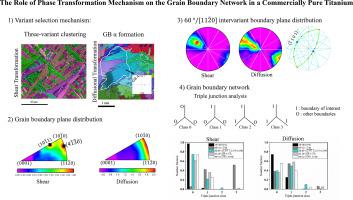当前位置:
X-MOL 学术
›
Mater. Charact.
›
论文详情
Our official English website, www.x-mol.net, welcomes your
feedback! (Note: you will need to create a separate account there.)
The role of phase transformation mechanism on the grain boundary network in a commercially pure titanium
Materials Characterization ( IF 4.8 ) Pub Date : 2020-11-01 , DOI: 10.1016/j.matchar.2020.110640 Ehsan Farabi , Vahid Tari , Peter D. Hodgson , Gregory S. Rohrer , Hossein Beladi
Materials Characterization ( IF 4.8 ) Pub Date : 2020-11-01 , DOI: 10.1016/j.matchar.2020.110640 Ehsan Farabi , Vahid Tari , Peter D. Hodgson , Gregory S. Rohrer , Hossein Beladi

|
Abstract The role of phase transformation mechanism on the development of the grain boundary network in a commercially pure Ti was investigated using five-parameter grain boundary analysis along with an analysis of the triple junctions among intervariant boundaries. High temperature β was subjected to three different cooling regimes (i.e., 175 °C/s, 1 °C/s and 0.02 °C/s) to stimulate shear, diffusion-assisted and pure diffusional β-to-α phase transformation mechanisms, resulting martensite, Widmanstatten, and coarse-grain microstructures, respectively. The phase transformation mechanism appeared to significantly alter the grain boundary network in pure Ti. There was a distinct difference in the misorientation angle distribution among microstructures formed through different phase transformation mechanisms, though the peaks were largely consistent with the Burgers orientation relationship. The 60°/ 1 1 2 ¯ 0 intervariant boundary had the highest population (~60%) in the martensitic/shear transformation, because of a local variant selection mechanism (i.e., three variant clustering) influenced by the transformation strain. However, the local variant selection associated with the transformation strain gradually diminished with a decrease in the cooling rate, leading to a progressive decline in the 60°/ 1 1 2 ¯ 0 population (i.e., the random distribution of intervariant boundaries). The 60°/ 1 1 2 ¯ 0 intervariant boundary had symmetric tilt 1 ¯ 1 0 1 plane characteristics with a low energy configuration in the martensitic microstructure and an asymmetric tilt character in both diffusion-assisted and diffusional transformations. The three-variant clustering during the martensitic transformation significantly enhanced the connectivity of the 60°/ 1 1 2 ¯ 0 intervariant boundaries at the triple junctions, though it became progressively less connected as the mechanism altered towards diffusion-assisted and diffusional phase transformations.
中文翻译:

相变机制对工业纯钛晶界网络的作用
摘要 使用五参数晶界分析以及互变边界之间的三重结分析,研究了相变机制对商业纯钛中晶界网络发展的作用。高温 β 经受三种不同的冷却方式(即 175 °C/s、1 °C/s 和 0.02 °C/s)以刺激剪切、扩散辅助和纯扩散 β-to-α 相变机制,分别产生马氏体、Widmanstatten 和粗晶粒显微组织。相变机制似乎显着改变了纯钛的晶界网络。不同相变机制形成的微结构的取向差角分布存在明显差异,尽管峰在很大程度上与 Burgers 取向关系一致。60°/ 1 1 2 ¯ 0 互变边界在马氏体/剪切转变中具有最高的群体(~60%),因为受转变应变影响的局部变体选择机制(即,三个变体聚类)。然而,随着冷却速率的降低,与转化应变相关的局部变体选择逐渐减少,导致60°/ 1 1 2 ¯ 0 种群(即互变边界的随机分布)逐渐下降。60°/ 1 1 2 ¯ 0 互变边界具有对称倾斜1 ¯ 1 0 1 平面特征,在马氏体微观结构中具有低能量配置,并且在扩散辅助和扩散转变中具有不对称倾斜特征。
更新日期:2020-11-01
中文翻译:

相变机制对工业纯钛晶界网络的作用
摘要 使用五参数晶界分析以及互变边界之间的三重结分析,研究了相变机制对商业纯钛中晶界网络发展的作用。高温 β 经受三种不同的冷却方式(即 175 °C/s、1 °C/s 和 0.02 °C/s)以刺激剪切、扩散辅助和纯扩散 β-to-α 相变机制,分别产生马氏体、Widmanstatten 和粗晶粒显微组织。相变机制似乎显着改变了纯钛的晶界网络。不同相变机制形成的微结构的取向差角分布存在明显差异,尽管峰在很大程度上与 Burgers 取向关系一致。60°/ 1 1 2 ¯ 0 互变边界在马氏体/剪切转变中具有最高的群体(~60%),因为受转变应变影响的局部变体选择机制(即,三个变体聚类)。然而,随着冷却速率的降低,与转化应变相关的局部变体选择逐渐减少,导致60°/ 1 1 2 ¯ 0 种群(即互变边界的随机分布)逐渐下降。60°/ 1 1 2 ¯ 0 互变边界具有对称倾斜1 ¯ 1 0 1 平面特征,在马氏体微观结构中具有低能量配置,并且在扩散辅助和扩散转变中具有不对称倾斜特征。











































 京公网安备 11010802027423号
京公网安备 11010802027423号